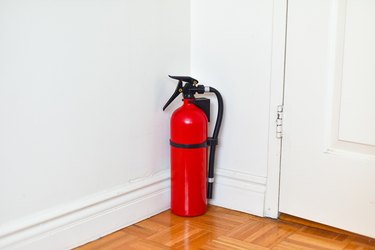
All homes need a fire extinguisher. Smoke detectors can alert you to a fire, but fire extinguisher can put out small flames before too much damage is done. The best places to keep an extinguisher are in the kitchen and garage, and if you have one, near the outdoor grill.
Because fire extinguishers are rated based on the type of fire they put out, make sure you have the appropriate one handy. The fire extinguisher's rating system may also affect its disposal method. Check with your local government or fire department for details about the disposal laws in your area. Generally, you have three options when disposing of an old extinguisher.
Video of the Day
Video of the Day
Fire Extinguisher Types
There are four basic types of fire extinguishers — dry chemical, water, carbon dioxide, and halon — and each extinguisher works for specific fires based on its classification label. The classification label defines the fire types it is meant to douse. Fire extinguisher classification labels include "A" for wood, paper, and ordinary flammables; "B" for liquid flammables, such as greases, gasoline, and oils; "C" for electrical fires; "D" for flammable metals; and "K" for commercial restaurants and cooking fires. Some extinguishers have multiple label ratings.
Give It a Refill
Before disposing of your extinguisher, see if you can refill it. No matter what the extinguisher was originally filled with, all fire extinguishers that are made entirely of metal can be refilled or recharged if necessary. Your local fire department will have information on how to refill and recharge in your area. There are also fire extinguisher recharging companies that you can find online. During recharging, the extinguisher gets a once-over to ensure that it is in proper working order and meets the current requirements for fire extinguisher construction and operation.
Recycle Your Unit
The bodies of most fire extinguishers consist of steel, a recyclable material. If the extinguisher is empty, squeeze the trigger to ensure that the unit holds no pressure and remove the plastic top and trigger. Take the canister to any recycling facility that processes steel. If the extinguisher is full or partly full, your local fire company can safely discharge it for you. After removing the top, take it to a recycling center. Some fire companies even recycle the extinguisher for you.
Throw It Away
Check with your local waste management facility to verify that it accepts discharged fire extinguishers with household trash. If it still shows pressure on its gauge, take it outside and gently squeeze the trigger. Let it sit for a day or two to thoroughly discharge before wrapping it inside a trash bag for disposal with household trash. Water and carbon dioxide extinguishers generally pose no environmental threats during disposal.
Some municipalities also allow dry chemical and halon extinguisher disposal with household trash, but only if they are completely empty. Others may consider these types of extinguishers hazardous whether they are full or not. If so, you will have to take them to a local hazardous waste center for disposal.
A Word of Warning
Be particularly careful when handling and disposing of older fire extinguishers. Extinguishers made prior to 1960 are often valued by collectors, but can be very dangerous. These extinguishers may contain carbon tetrachloride.
Carbon tetrachloride works extremely well as a fire extinguisher, but is a known carcinogen. Exposure can be fatal if enough of the chemical is inhaled or absorbed through the skin. When heated, carbon tetrachloride produces phosgene — more commonly known as nerve gas. Use extreme caution with older fire extinguishers and contact your local fire department for guidance on how to transport and dispose of them safely.